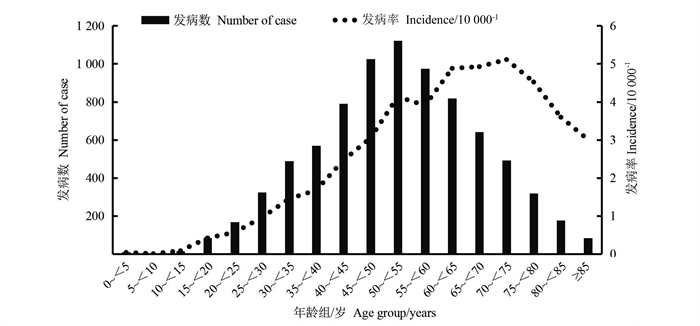Epidemiological trends and spatiotemporal clustering of hepatitis E in Fujian Province, 2014-2023
-
摘要:
目的 分析福建省戊型病毒性肝炎(简称戊肝)的流行趋势和时空聚集性。 方法 通过中国疾病预防控制信息系统收集2014―2023年福建省戊肝报告发病数据,运用Joinpoint 5.1.0.0模型描述报告发病率的变化趋势,使用SaTScan V9.5软件进行时空扫描分析。 结果 2014―2023年福建省共报告戊肝病例8 108例,年均报告发病率为2.05/10万,2014―2020年呈下降趋势(APC=-7.41%, 95% CI: -22.09%~2.25%, P=0.009),2020―2023年呈上升趋势(APC=15.95%, 95% CI: 0.94%~42.43%, P=0.034)。戊肝主要流行季节在冬春季,男性戊肝报告发病率高于女性(χ2 =583.42, P < 0.001),报告发病率随年龄的增长总体呈上升趋势(趋势χ2 =4 607.00, P < 0.001)。时空扫描分析发现7类戊肝空间聚集区域。 结论 2014―2023年福建省戊肝报告发病率呈先下降后上升趋势,中老年男性为主要发病人群,发病分布存在时空聚集性,需加强高危人群和热点地区的戊肝监测和防控。 Abstract:Objective To analyze the epidemic trend and spatiotemporal clustering of hepatitis E in Fujian Province. Methods The reported incidence data of hepatitis E in Fujian Province from 2014 to 2023 were collected through the China information system for disease control and prevention. The change trend of the reported incidence rate was described using the Joinpoint 5.1.0.0 model. Spatiotemporal scanning analysis was performed using SaTScan V9.5 software. Results A total of 8108 cases of hepatitis E were reported in Fujian Province during 2014-2023, for an average annual reported incidence of 2.05 per 100 000. there was a downward trend (APC=-7.41%, 95% CI: -22.09%-2.25%, P=0.009), while from 2020 to 2023, there was an upward trend (APC=15.95%, 95% CI: 0.94%-42.43%, P=0.034). The main epidemic season was winter and spring. The reported incidence rate of hepatitis E in men was higher than that in women (χ2 =583.42, P < 0.001), and the reported incidence rate showed an over all upward trend with the increase of age (χ2 =4 607.00, P < 0.001). The spatiotemporal scan analysis has revealed seven types of spatial clustering areas for hepatitis E. Conclusions From 2014 to 2023, the reported incidence rate of hepatitis E in Fujian Province showed a downward trend and then an upward trend middle aged and elderly men were the main affected population, and the incidence was spatiotemporal clustering. It was necessary to strengthen the monitoring of hepatitis E in high-risk groups and hot spots. -
Key words:
- Viral hepatitis E /
- Popular trends /
- Spatiotemporal clustering
-
表 1 2014―2023年福建省戊型病毒性肝炎报告发病率时空扫描分析
Table 1. Spatiotemporal scan analysis results of incidence rate of hepatitis E in Fujian province, 2014-2023
聚集类型
Type of cluster聚集城市
[县(区)数/个]
Aggregated cities (the number of counties districts/case)半径
Radius /km聚集时间/ 年
Gathering time/ year报告病例数
Number of cases期望病例数
Expected cases波及人口数/万
Population /10 000RR值
valueLLR值
valueP值
value一类 Class Ⅰ 龙岩市(1) Longyan City (1) 0 2015―2016 124 9.73 24.52 12.93 202.17 < 0.001 二类 Class Ⅱ 三明市(8)、南平市(5)Sanming City (8), Nanping City (5) 105.05 2014―2015 328 115.47 305.82 2.92 132.77 < 0.001 三类 Class Ⅲ 福州市(3)、宁德市(7)Fuzhou City (3), Ningde City (7) 89.31 2014―2015 292 128.59 365.17 2.32 77.76 < 0.001 四类 Class Ⅳ 厦门市(1) Xiamen City (1) 9.88 2018―2019 96 41.75 102.87 2.32 25.87 < 0.001 五类 ClassⅤ 泉州市(1)Quanzhou City (1) 0 2022―2023 41 16.43 38.47 2.50 12.96 0.002 六类 ClassⅥ 平潭综合实验区(1)Pingtan Comprehensive Experimental Zone(1) 0 2022―2022 55 7.77 41.65 7.12 60.53 < 0.001 七类 ClassⅦ 福州市(7)、莆田市(1)Fuzhou City (7), Putian City (1) 48.82 2022―2023 500 217.59 550.46 2.38 138.75 < 0.001 -
[1] Kamar N, Bendall R, Legrand-Abravanel F, et al. Hepatitis E [J]. Lancet, 2012, 379(9835): 2477-2488. DOI: 10.1016/S0140-6736(11)61849-7. [2] 陈奕娟, 孙琬琬, 陈直平, 等. 2005―2020年浙江省戊型病毒性肝炎时空特征[J]. 中华疾病控制杂志, 2023, 27(9): 1101-1106. DOI: 10.16462/j.cnki.zhjbkz.2023.09.020.Chen YJ, Sun WW, Chen ZP, et al. Spatio-temporal analysis of hepatitis E in Zhejiang Province from 2005 to 2020 [J]. Chin J Dis Control Prev, 2023, 27(9): 1101-1106. DOI: 10.16462/j.cnki.zhjbkz.2023.09.020. [3] 马涛, 丁松宁, 汪君君, 等. 2010―2022年南京市戊型病毒性肝炎流行病学特征和空间聚集性[J]. 中国疫苗和免疫, 2023, 29(5): 539-543. DOI: 10.19914/j.CJVI.2023094.Ma T, Ding SN, Wang JJ, et al. Epidemiological characteristics and spatial clustering of viral hepatitis E in Nanjing city from 2010 to 2022 [J]. Chinese Journal of Vaccines and Immunology, 2023, 29(5): 539-543. DOI: 10.19914/j.CJVI.2023094. [4] Di Cola G, Fantilli AC, Pisano MB, et al. Foodborne transmission of hepatitis A and hepatitis E viruses: a literature review [J]. Int J Food Microbiol, 2021, 338: 108986. DOI: 10.1016/j.ijfoodmicro.2020.108986. [5] 黄澳迪, 唐林, 王晓琪, 等. 中国2011―2021年戊型病毒性肝炎发病趋势和时空聚集性[J]. 中国疫苗和免疫, 2022, 28(4): 417-421. DOI: 10.19914/j.CJVI.2022080.Huang AD, Tang L, Wang XQ, et al. Hepatitis E incidence trends and spatial-temporal clustering in China, 2011-2021 [J]. Chinese Journal of Vaccines and Immunization, 2022, 28(4): 417-421. DOI: 10.19914/j.CJVI.2022080. [6] 李涛, 候立娟, 李清茹, 等. 2016―2021年安徽省百日咳空间自相关及时空聚集性[J]. 中华疾病控制杂志, 2023, 27(11): 1247-1253. DOI: 10.16462/j.cnki.zhjbkz.2023.11.002.Li T, Hou LJ, Li QR, et al. Spatial autocorrelation and spatial-temporal clustering analysis of pertussis in Anhui Province from 2016 to 2021 [J]. Chin J Dis Control Prev, 2023, 27(11): 1247-1253. DOI: 10.16462/j.cnki.zhjbkz.2023.11.002. [7] Shi Y, Shen WQ, Liu WD, et al. Analysis of the spatial-temporal distribution characteristics of hepatitis E in Jiangsu Province from 2005 to 2020 [J]. Front Public Health, 2023, 11: 1225261. DOI: 10.3389/fpubh.2023.1225261. -





 下载:
下载:

